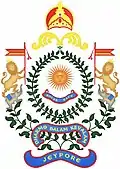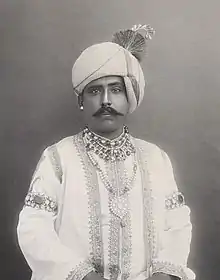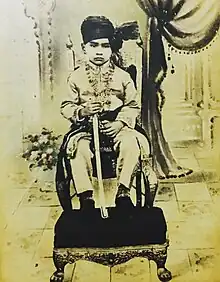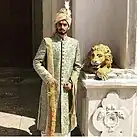Maharaja of Jeypore
Maharaja of Jeypore was the principal title used by the rulers of the Kingdom of Jeypore until its dissolution in 1947. It was also used by the titular rulers until the removal of titles and privileges of all princely states and estates by the 26th amendment of the Constitution of India. However, due to the significance given to the traditional and religious role of a king, evidently, Vishweshwar Dev in 2013 became the Maharaja of Jeypore in pretense.[1]
| Maharaja of Jeypore | |
|---|---|
 Coat of arms (1898) | |
 Vikram Dev III, the Maharaja of Jeypore | |
| Details | |
| Style | His Highness |
| First monarch | Vinayak Dev |
| Last monarch | Vikram Dev IV |
| Formation | 1443 |
| Abolition | 15 August 1947 |
| Residence | Moti Mahal Palace |
| Pretender(s) | Vishweshvar Dev |
The Silavamsa dynasty of Nandapur slowly absorbed the Matsya dynasty of Madugula(modern Andhra Pradesh) through matrimonial alliance, the Matsya family became extinct within the Silavamsa lineage. The Silavamsa king Pratap Ganga Raja died without any male heir, only leaving behind his wife and daughter Lilavati. Vinayak Dev who migrated from Kashmir after praying to Kashi Vishwanath married Lilavati. Accordingly, the dynasty was called Śaṅkaravamśa or Shankara Dynasty named in respect of Hindu God Shiva.
Vinayak Dev claimed to belong to the legendary Solar dynasty or Suryavansh.[2][3] The first three rulers served as the vassals of the mighty Gajapati Kingdom until the reign of Vishwanath Dev Gajapati (1527-1571) who formed a large sovereign kingdom and ruled from the new capital, Rayagada.[4] The kingdom maintained its sovereignty for much of its history, however, in some intervals it also served as a Tributary state of the Qutb Shahis (1571-1674) and the British (1777-1947).
The eighth ruler of the dynasty, Veer Vikram Dev (1637-1669) shifted the capital from Nandapur to newly founded Jeypore.[5] His descendants successfully maintained and expanded the kingdom by installing numerous feudatories that paid homage to them. Some contemporary historical sources consider Vishwambhara Dev as the father of the kingdom’s significant feudal system. Many feudatories established by him exist to this day, some examples can be - Salur, Pachipenta, Chemudu, Golugonda, Khariar etc. The eleventh ruler, Mallikamardhan Krishna defeated the combined forces of the French East India Company and the Qutb Shahi commander, Malik Mohammad.[2]
The advent of British did put the dynasty of the Maharajas in jeopardy as the 19th ruler, Vikram Dev was defeated and all of his territories were occupied by the British and were granted to the Raja of Vizianagaram who was formerly a feudal chieftain under Jeypore. However, the resilience of the natives of Jeypore and the rising number of violent protests forced the British government to reaffirm Vikram Dev as the ruler but as a tributary estate holder or Zamindar in a permanent settlement of 24,000 rupees. The title of 'Maharaja' was abolished and a new title of 'Raja' was granted to the first three kings of the newly formed Jeypore Samasthanam zamindari.[2] These kings were - Vikram Dev, Ram Chandra Dev II and Vikram Dev II. Later, the British government granted Ram Chandra Dev III the title of 'Maharaja' as a personal distinction and to the next three kings - Vikram Dev III, Ram Chandra Dev IV and Vikram Dev IV.
Genealogy of Sankaravamsa
| No. | Name (Birth–Death) |
Portrait | Title(s) | Reigned from | Reigned until |
|---|---|---|---|---|---|
| 1 | Vinayak Dev (Raja Vinayak) (c.1415-1476) |
 |
Raja of Nandapur The 1st Çankara dynasty ruler |
1443 | 1476 |
| Vinayak Dev inherited the kingdom from Pratap Ganga Raj, the last Shilavanshi ruler of Nandapur. He conquered territories up to Guntur across the river Krishna.[2] | |||||
| 2 | Vijaychandraksha Dev (Raja Vijaychandraksha) (1450-1510) |
 |
Raja of Nandapur | 1476 | 1510 |
| Son of Vinayak Dev, he was a contemporary of Purshottam Dev Gajapati of Cuttack. He assisted the Gajapati Maharaja on his expedition to Kanchipuram against the King of Vijaynagar. Brought the idols of Sri Vallabh Narayan Mahaprabhu and Sri Kanak Durga Amma from Kanchi.[2] | |||||
| 3 | Bhairav Dev (Raja Bhairav) (1482–1527) |
 |
Raja of Nandapur | 1510 | 1527 |
| Only son of Vijaychandraksha, he aided Prataparudra Deva against the army of Krishnadevaraya in the defense of Kondapalli Fort[3] | |||||
| 4 | Vishwanath Dev Gajapati (Maharaja Vishwanath Gajapati) (1519-1571) |
 |
Raja of Nandapur,
Maharajadhiraja |
1527 | 1571 |
| The most prestigious names of the dynasty, he conquered a large territory that stretched from the confines of Bengal in North to River Krishna in South. | |||||
| 5 | Balaram Dev (Raja Balaram) (1545–1597) |
 |
Maharaja of Nandapur | 1571 | 1597 |
| Only son of Vishwanath Dev Gajapati, he lost the battle to the Qutb Shahi dynasty of Golconda and became a tributary ruler. | |||||
| 6 | Yashasvan Dev (Raja Yashasvan) (1568–1637) |
 |
Maharaja of Nandapur | 1597 | 1637 |
| Only son of Balaram Dev, he raised a large army, united the chieftains and fought against the Qutb Shahis but lost. | |||||
| 7 | Krishna Raj Dev (Raja Krishnaraj) (1595–1637) |
 |
Maharaja of Nandapur | 1637 | 1637 |
| Nephew of Yashasvan Dev, he sided with the Qutb Shahi against his uncle and was made the king in 1637, his regime lasted for only a few months. | |||||
| 8 | Vir Vikram Dev (Maharaja Vir Vikram) (1617–1669) |
Maharaja of Nandapur &Jeypore | 1637 | 1669 | |
| Son of Yashasvan Dev, he dethroned his uncle and shifted the capital to Jeypore, this new place was founded by him. He was a friend of Abdullah Qutb Shah and was granted the illustrious title of Azeem Maharaja Yujadud Dowla Mahabat Assar Yedal Yemeeney Saltanat Samasamay Qilapathey Islam Sri Jhadkhand Badshah Maharajadhiraj Maharaja | |||||
| 9 | Krishna Dev (Maharaja Krishna) (1620–1672) |
Maharaja of Jeypore | 1669 | 1672 | |
| Elder son of Vir Vikram Dev, he ruled for over three years and is known for establishing some crucial feudatories in the modern North Andhra region. He granted the Kumuli-Gandredu villages as a fief to the Pusapati Sitaram Raz and protested against the control of Qutb Shahis. | |||||
| 10 | Vishwambhar Dev (Maharaja Vishwambhar) (1650–1676) |
Maharaja of Jeypore, Maharajadhiraja of Kalinga | 1672 | 1676 | |
| Eldest son of Krishna Dev, he is known as the father of the feudal system of Jeypore because of his idea of creating many feudatories. He was a known warrior in the battlefied as he defeated the Governor(Nawab) of Chicacole appointed by the Qutb Shahi Sultan and became a sovereign monarch. He controlled the entire region of North Andhra and defeated the Dutch East India Company who used to capture natives living in the Andhra coast for the purpose of slavery. The Dutch called him 'Sumber Deo'. | |||||
| 11 | Mallikamardhan Krishna Dev (Maharaja Mallikamardhan Krishna) (1652–1681) |
Maharaja of Kalinga | 1676 | 1681 | |
| Second son of Krishna Dev, he succeeded his brother Vishwambhar Dev after his unfortunate death and soon led an army to face the alliance of French East India Company and the Qutb Shahi Sultanate. The Maharaja was called Mallikamardhan or the 'Destroyer of Malik' after he slayed the military commander of Golconda named, Malik Mohammad and defeated the alliance. He captured 15 French canons and died due to illness after a short rule of five years. | |||||
| 12 | Hari Dev (Maharaja Hari) (1658–1684) |
Maharaja of Kalinga | 1681 | 1684 | |
| Third son of Krishna Dev, he inherited the kingdom after the death of his two elder brothers. He was a weak and inexperienced king ruling for a short term of three years. | |||||
| 13 | Balaram Dev II (Maharaja Balaram II) (1659–1686) |
Maharaja of Kalinga | 1684 | 1686 | |
| Youngest son of Krishna Dev, he ruled for a mere two years and relinquished the title in favor of Raghunath Krishna Dev who was adopted by him from the Gunupar Fief ruled by his first cousin, Vishwanath Dev. | |||||
| 14 | Raghunath Krishna Dev (Maharaja Raghunath Krishna) (1668–1708) |
Maharaja of Kalinga | 1686 | 1708 | |
| Adopted by his uncle Balaram Dev II from the junior line of the dynasty that ruled over a fief called Gunupur. He proved to be a great administrator and militaryman. He defeated the first Mughal Subedar of the region appointed by Aurangzeb and destroyed the European factories established in the coast of Visakhapatnam. In his rule, the kingdom enjoyed decent amount of wealth from their feudatories. | |||||
| 15 | Ram Chandra Dev I (Maharaja Ram Chandra I) (1687–1711) |
Maharaja of Kalinga | 1708 | 1711 | |
| Eldest son of Raghunath Krishna, he was crowned at the age of 22. His group of ministers included Viziaram Raz (founder of Vizianagaram estate), who was later appointed as the prime minister of the kingdom by Maharaja Ram Chandra. This infuriated his younger brother, Balaram Dev III who was suspicious about the new minister. Later, Balaram rebels and captures the fort of Narayanapatna. The minister, Viziaram instigates the Maharaja to capture Balaram Dev. Initially, Ram Chandra dies in mysterious circumstances when he was on his way to Narayanapatna. | |||||
| 16 | Balaram Dev III (Maharaja Balaram III) (1689–1713) |
Maharaja of Jeypore | 1711 | 1713 | |
| Second son of Raghunath Krishna Dev, he inherited the kingdom following the death of his brother, Ram Chandra Dev I. He rebelled against his brother and captured the fort of Narayanapatna. He became the king at a critical time when the numerous feudatories of Jeypore across the Eastern Ghats in the North Andhra region claimed independence from the control of Jeypore Maharaja. He ruled for two years. | |||||
| 17 | Vishwambhar Dev II (Maharaja Vishwambhar II) (1691–1752) |
Maharaja of Jeypore | 1713 | 1752 | |
| Third son of Raghunath Krishna Dev, he was crowned after the unexpected deaths of his two brothers. He was peaceful, pleasure loving and a great devottee of Lord Sri Krishna. In his reign, Jeypore kept a peaceful stance as the region was witnessing daily skirmishes between the French, British and other little kingdoms (former feudatories). He was inspired by the cult of Sri Chaitanya Mahaprabhu and retired from kinship to attain Sanyas. In 1752, he retired from his duties, appointed his younger brother as the next king and entered the cave of a hill called Atma Parvat, never to be seen again. | |||||
| 18 | Lal Krishna Dev (Maharaja Lal Krishna) (1710–1752) |
Maharaja of Jeypore | 1752 | 1758 | |
| Fourth son of Raghunath Krishna Dev, he ascended the throne in Narayanapatna after the retirement of his brother, Vishwambhar Dev II. His rule began in a very critical period when the kingdom of Jeypore was stuck in the middle of a conflict of three giants who were contesting for the control of the region. These giants were - French, British, Marathas and they were surrounding Jeypore in all four directions. Maharaja Lal Krishna had an ongoing tension and argument with his younger brother, Vikram Dev, who was also the commander-in-chief of the kingdom's army. The latter did not support the administrative decisions of his brother, the Maharaja, and hence took over the kingdom by a successful military coup. | |||||
| 19 | Vikram Dev I (Maharaja Vikram) (1758–1781) |
 |
Maharaja of Jeypore,
Raja of Jeypore (title awarded by the British East India Company) |
1758 | 1781 |
| The youngest son of Raghunath Krishna Dev, he succeeded as the new king after the succession of his four brothers. He served in the kingdom's military for a long span of time and gained enough experience in military affairs. He dethroned his brother after a successful military coup and became the Maharaja of Jeypore. He is mentioned as a great warrior in the chronicles of Jeypore, as he battled and defeated the French in Malkangiri, Marathas in Umerkote but lost the two battles to the British and Vizianagaram alliance. He was pardoned by the British and was reaffirmed as the king of Jeypore which was demoted to a zamindari under the British government of Madras Presidency. | |||||
| 20 | Ram Chandra Dev II (Maharaja Ram Chandra II) (1745–1825) |
Raja of Jeypore, Maharaja of Jeypore | 1781 | 1825 | |
| Eldest son of Vikram Dev I, he became the first king of the newly transformed Jeypore Zamindari, a baronial tributary estate of the British. He defeated the army of Bastar State who were encroaching upon the lands of Jeypore. He constructed the famous 'Jagganath Sagar' lake in Jeypore to promote tourism and employment.[6] | |||||
| 21 | Vikram Dev II (Maharaja Vikram II) (1668–1860) |
Raja of Jeypore | 1825 | 1860 | |
| Only son of Ram Chandra Dev II, he inherited the estate after the death of his father. He was a noble ruler who took interest in the development of courts, hospitals and schools. He was imprisoned by his son in the fort of Rayagada and later voluntarily transferred his power to his eldest son. | |||||
| 22 | Ram Chandra Dev III (Maharaja Ram Chandra III) (1687–1711) |
Maharaja of Jeypore | 1860 | 1889 | |
| Eldest son of Vikam Dev II, he imprisoned his father in the fort of Rayagada and was later crowned as the Maharaja of Jeypore. He had the opportunity to meet Prince Edward VII when the Prince of Wales visited Madras in 1875 and was awarded with a medal. | |||||
| 23 | Vikram Dev III (Maharaja Vikram III) (1874–1920) |
 |
His Highness the Maharaja of Jeypore | 1889 | 1920 |
| Eldest son of Ram Chandra Dev III, he was crowned in 1889 and assumed power in 1895. He was an educated gentlemen and a liberal phikantropist. For his noble work, he was awarded the style of Highness and knighted with the rank of KCIE. He built the new palace and the current residence of the royal family called Moti Mahal Palace. | |||||
| 24 | Ram Chandra Dev IV (Maharaja Ram Chandra IV) (1687–1711) |
His Highness the Maharaja of Jeypore | 1920 | 1931 | |
| Only son of Vikam Dev III, he inheried the estate after the demise of his father. He was awarded the rank of a Lieutenant for helping the British in the First World War. He also served as a pro-chancellor of Andhra University. He is known for being a reformer and took great interest in promoting education. He died issueless and was succeeded by his uncle, Vikram Dev IV. | |||||
| 25 | Vikram Dev IV (Maharaja Vikram IV) (1869–1951) |
His Highness the Maharajadhiraja Maharaja of Jeypore | 5 June 1931 | 14 April 1951 | |
| Only son of Krishna Chandra Dev, the prince of Jeypore and the younger brother of Ram Chandra Dev III. Evidently, Maharaja Vikram Dev IV succeeded his nephew, Ram Chandra Dev IV who died issueless. He was a well-known scholar and a polyglot who was affluent in five languages - Odia, Telugu, Bengali, Hindi and English. He was a playwright and was awarded the Doctorate degree of Kalaprapoorna by the Andhra University. He later became the pro-chancellor of Andhra University and donated liberally for to the University. He was the last official ruler of Jeypore.[7] | |||||
| 26 | Ram Krishna Dev (Maharaja Ram Krishna Dev) (titular) (pretender) (1687–1711) |
 |
His Highness the Maharaja of Jeypore | 17 April 1951 | 2006 |
| Born to Maharajakumari Swarnarekhamani Devi, the daughter of Vikram Dev IV, he was adopted by his grandfather and appointed as his next successor. His rule began in a democratic India where he just enjoyed the title without any authoritative powers. In 2006, the Maharaja and his eldest son Yuvraj Shakti Vikram Dev died and the estate was looked after by his wife and regent, Rama Kumari Devi. | |||||
| 27 | Vishweshvar Chandrachud Dev (Maharaja Vishweshvar) (pretender) |
 |
His Highness the Maharaja of Jeypore | 14 January 2013 | |
| Only son of Maharajkumar Vibhuti Bhusan Dev, the younger son of Ram Krishna Dev. After the death of the crown prince Shakti Vikram Dev, the Rajamata Rama Kumari Devi became a regent from 2006-2013. Vishweshvar was crowned as the pretending Maharaja of Jeypore under the instructions of his grand mother as he was the only surviving heir of the dynasty. His tenure began in 2013. | |||||
References
- Satyanarayan Pattnaik (Jan 15, 2013). "Jeypore hails its new 'lord' | Bhubaneswar News - Times of India". The Times of India. Retrieved 2021-04-12.
- Senapati, Neelmani; Sahu, Nabin Kumar (1966). Orissa District Gazetteers: Koraput. Cuttack: Government of Odisha. p. 59.
- Singh Deo, Kumar Bidyadhar (1975). Nandapur - A Forsaken Kingdom (Second ed.). Cuttack: Utkal Press. p. 14.
- Briggs, John (2015). History of the Rise of the Mahomedan power in India, till the year AD 1621. Cambridge, London: Cambridge University Press. p. 362.
- "History | Koraput District, Government Of Odisha | India". Retrieved 2021-04-12.
- "Where the 'holy cannon' is worshipped on Dussehra". The New Indian Express. Retrieved 2021-04-12.
- "Andhra University to celebrate 150th birth anniversary of Maharaja Vikram Deo - Times of India". The Times of India. 26 June 2019. Retrieved 2021-04-12.